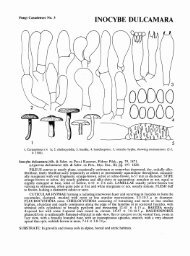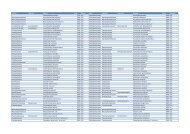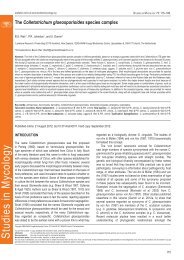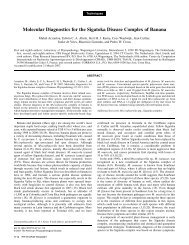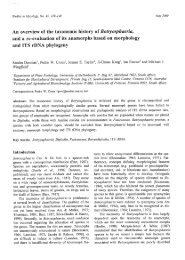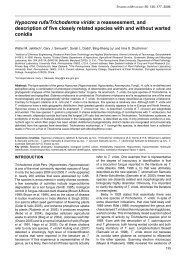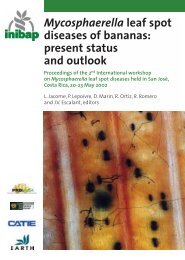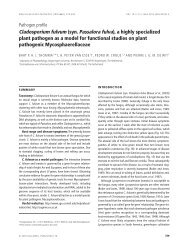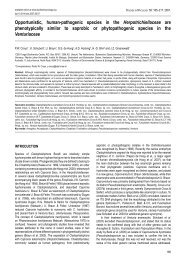Acremonium phylogenetic overview and revision of ... - CBS - KNAW
Acremonium phylogenetic overview and revision of ... - CBS - KNAW
Acremonium phylogenetic overview and revision of ... - CBS - KNAW
You also want an ePaper? Increase the reach of your titles
YUMPU automatically turns print PDFs into web optimized ePapers that Google loves.
ACKNOWleDGeMeNTs<br />
We greatly thank Arien van Iperen, Bert Gerrits-van den Ende, <strong>and</strong> Kasper<br />
Luijsterburg for essential technical support in this study, as well as Keith Seifert<br />
<strong>and</strong> Steve Rehner for scientific contributions. Key work was done by co-op students<br />
Salvatore Lopes, Saghal Ahmed-Suleyman, Arwin van der Rhee, <strong>and</strong> Nienke<br />
Lancee as well as visiting Canadian student Jonathan Shapero. For sending type<br />
cultures, we thank Akira Nakagiri <strong>of</strong> the NITE Biological Resource Centre Fungi<br />
collection <strong>and</strong> Françoise Symoens <strong>of</strong> the BCCM-IHEM collection. The staff <strong>of</strong> the<br />
<strong>CBS</strong> Collection deserve special thanks for strain cultivation <strong>and</strong> additional work.<br />
The encouragement <strong>and</strong> mentorship <strong>of</strong> Walter Gams is highly appreciated, <strong>and</strong> we<br />
hope our partial resolution <strong>of</strong> the dilemmas posed by <strong>phylogenetic</strong> systematics in<br />
<strong>Acremonium</strong> will be recognised as complementary to his invaluable work.<br />
ReFeReNCes<br />
Arx JA von, Mukerji KG, Singh N (1978). Leucosphaera, a new genus <strong>of</strong> the<br />
Pseudeurotiaceae. Persoonia 10: 141–143.<br />
Bachmann HP, Bobst C, Bütik<strong>of</strong>er U, Casey MG, Dalla Torre M, Fröhlich-Wyder MT,<br />
Fürst M (2005). Occurrence <strong>and</strong> significance <strong>of</strong> Fusarium domesticum alias<br />
Anticollanti on smear-ripened cheeses. LWT - Food Science <strong>and</strong> Technology<br />
38: 399–407.<br />
Bills GF, Platas G, Gams W (2004). Conspecificity <strong>of</strong> the cerulenin <strong>and</strong> helvolic<br />
acid producing ‘Cephalosporium caerulens’, <strong>and</strong> the hypocrealean fungus<br />
Sarocladium oryzae Mycological Research 108: 1291–1300.<br />
Castlebury LA, Rossman AY, Sung GH, Hyten AS, Spatafora JW (2004). Multigene<br />
phylogeny reveals new lineage for Stachybotrys chartarum, the indoor air<br />
fungus. Mycological Research 108: 864–872.<br />
Dickinson CH (1968). Gliomastix Guéguen. Mycological Papers 115: 1–26.<br />
Domsch KH, Gams W, Anderson T-H (2007) Compendium <strong>of</strong> soil fungi. IHW-Verl.,<br />
Eching, Germany.<br />
Gams W (1968). Typisierung der Gattung <strong>Acremonium</strong>. Nova Hedwigia 16: 141–145.<br />
Gams W (1971). Cephalosporium-artige Schimmelpilze (Hyphomycetes). 1–262.<br />
G. Fischer, Stuttgart.<br />
Gams W (1975). Cephalosporium-like Hyphomycetes: some tropical species.<br />
Transactions <strong>of</strong> the British Mycological Society 64: 389–404.<br />
Gams W (1978). Connected <strong>and</strong> disconnected chains <strong>of</strong> phialoconidia <strong>and</strong><br />
Sagenomella gen. nov. segregated from <strong>Acremonium</strong>. Persoonia 10: 97–112.<br />
Gams W, Hawksworth DL (1976) [‘1975’]. The identity <strong>of</strong> Acrocylindrium oryzae<br />
Sawada <strong>and</strong> a similar fungus causing sheath rot <strong>of</strong> rice. Kavaka 3: 57–61.<br />
Gams W, Lacey J (1972). Cephalosporium-like Hyphomycetes. Two species <strong>of</strong><br />
<strong>Acremonium</strong> from heated substrates. Transactions <strong>of</strong> the British Mycological<br />
Society 59: 519–522.<br />
Gams W, McGinnis MR (1983). Phialemonium, a new anamorph genus intermediate<br />
between Phialophora <strong>and</strong> <strong>Acremonium</strong>. Mycologia 75: 977–987.<br />
Gams W, O’Donnell K, Schroers H-J, Christensen M (1998). Generic classification<br />
<strong>of</strong> some more hyphomycetes with solitary conidia borne on phialides. Canadian<br />
Journal <strong>of</strong> Botany 76: 1570–1583.<br />
Gargas A, Taylor JW (1992). Polymerase chain reaction (PCR) primers for amplifying<br />
<strong>and</strong> sequencing 18S rDNA from lichenized fungi. Mycologia 84: 589–592.<br />
Glenn AE, Bacon CW, Price R, Hanlin RT (1996). Molecular phylogeny <strong>of</strong><br />
<strong>Acremonium</strong> <strong>and</strong> its taxonomic implications. Mycologia 88: 369–383.<br />
Gómez BL, Nosanchuk JD (2003). Melanin <strong>and</strong> fungi. Current Opinion in Infectious<br />
Disease 16: 91–96.<br />
Gräfenhan T, Schroers H-J, Nirenberg HI, Seifert KA (2011). An <strong>overview</strong> <strong>of</strong> the<br />
taxonomy, phylogeny, <strong>and</strong> typification <strong>of</strong> nectriaceous fungi in Cosmospora,<br />
<strong>Acremonium</strong>, Fusarium, Stilbella, <strong>and</strong> Volutella. Studies in Mycology 68: 79–<br />
113 (this issue).<br />
Hammill TM (1981). On Gliomastix murorum <strong>and</strong> G. felina. Mycologia 73: 229–237<br />
Hoog GS de, Guarro J, Gené J, Figueras MJ (2000). Atlas <strong>of</strong> Clinical Fungi. 2 nd ed.<br />
Utrecht, Netherl<strong>and</strong>s: Centraalbureau voor Schimmelcultures.<br />
Hoog GS de, Gerrits van den Ende AHG (1998). Molecular diagnostics <strong>of</strong> clinical<br />
strains <strong>of</strong> filamentous basidiomycetes. Mycoses 41: 183–189.<br />
Hughes SJ (1958). Revisiones hyphomycetum aliquot cum appendice de nominibus<br />
rejiciendis. Canadian Journal <strong>of</strong> Botany 36: 727–836.<br />
Ito T, Okane I, Nakagiri A, Gams W (2000). Two species <strong>of</strong> <strong>Acremonium</strong> section<br />
<strong>Acremonium</strong>: A. borodinense sp. nov. <strong>and</strong> A. cavaraeanum rediscovered.<br />
Mycological Research 104: 77–80.<br />
Kiyuna T, An K-D, Kigawa R, Sano C, Miura S, Sugiyama J (2010). Molecular<br />
assessment <strong>of</strong> fungi in ‘‘black spots" that deface murals in the Takamatsuzuka<br />
<strong>and</strong> Kitora Tumuli in Japan: <strong>Acremonium</strong> sect. Gliomastix including <strong>Acremonium</strong><br />
tumulicola sp. nov. <strong>and</strong> <strong>Acremonium</strong> felinum comb. nov. Mycoscience 52: 1–17.<br />
Lechat C, Farr DF, Hirooka Y, Minnis AM, Rossman AY (2010). A new species <strong>of</strong><br />
Hydropisphaera, H. bambusicola, is the sexual state <strong>of</strong> Gliomastix fusigera.<br />
Mycotaxon 111: 95–102.<br />
www.studiesinmycology.org<br />
acremonium phylogeny<br />
Liang ZQ, HanYF, Chu HL, Fox RTV (2009). Studies on the genus Paecilomyces<br />
in China V. Taifanglania gen. nov. for some monophialidic species. Fungal<br />
Diversity 34: 69–77.<br />
Link H (1809). Observationes in ordines plantarum naturals. Gesellschaft<br />
Naturforschender Freunde zu Berlin Magazin 3: 1–42.<br />
Lutzoni F, Wagner P, Reeb V, Zoller S (2000). Integrating ambiguously aligned<br />
regions <strong>of</strong> DNA sequences in <strong>phylogenetic</strong> analyses without violating positional<br />
homology. Systematic Biology 49: 628–651<br />
Maddison WP, Maddison DR (2003). MacClade: analysis <strong>of</strong> phylogeny <strong>and</strong> character<br />
evolution. V. 4.06. Sinauer, Sunderl<strong>and</strong>, Massachusetts.<br />
Malloch D (1989). An undescribed species <strong>of</strong> Leucosphaerina. Studies in Mycology<br />
31: 107–111.<br />
Mason-Gamer R, Kellogg E (1996). Testing for <strong>phylogenetic</strong> conflict among<br />
molecular datasets in the tribe Triticeae (Graminae). Systematic Biology 45:<br />
524–545.<br />
Matsushima T (1975). Icones Micr<strong>of</strong>ungorum a Matsushima lectorum. Published by<br />
the author, Kobe, Japan, 209 pp.<br />
Mel’nik V, Lee S, Groenewald J Z, Crous PW (2004). New hyphomycetes from<br />
Restionaceae in fynbos: Parasarcopodium ceratocaryi gen. et sp. nov., <strong>and</strong><br />
Rhexodenticula elegiae sp. nov. Mycological Progress 3: 19–28.<br />
Morgan-Jones G, Gams W (1982). Notes on Hyphomycetes. XLI. An endophyte <strong>of</strong><br />
Festuca arundinacea <strong>and</strong> the anamorph <strong>of</strong> Epichloe typhina, new taxa in one<br />
<strong>of</strong> two new sections <strong>of</strong> <strong>Acremonium</strong>. Mycotaxon 15: 311–318.<br />
Novicki TJ, LaFe K, Bui L, Bui U, Geise R, Marr K, Cookson BT (2003). Genetic<br />
diversity among clinical isolates <strong>of</strong> <strong>Acremonium</strong> strictum determined during an<br />
investigation <strong>of</strong> a fatal mycosis. Journal <strong>of</strong> Clinical Microbiology 41: 2623–2628.<br />
O’Donnell K (1993). Fusarium <strong>and</strong> its near relatives. In: The fungal holomorph:<br />
mitotic, meiotic <strong>and</strong> pleomorphic speciation in fungal systematics. (Reynolds<br />
R, Taylor JW, eds.), CBA International, Wallingford, United Kingdom: 225–233.<br />
Perdomo H, Sutton DA, García D, Fothergill AW, Cano J, Gené J, Summerbell<br />
RC, Rinaldi MG, Guarro J (2010). Spectrum <strong>of</strong> clinically relevant <strong>Acremonium</strong><br />
species in the United States. Journal <strong>of</strong> Clinical Microbiology. doi:10.1128/<br />
JCM.00793-10<br />
Raper JR, Raper CA (1972). Genetic analysis <strong>of</strong> the life cycle <strong>of</strong> Agaricus bisporus.<br />
Mycologia 64:1088–1117.<br />
Reeb V, Roux C, Lutzoni F (2004). Contribution <strong>of</strong> RPB2 to multilocus <strong>phylogenetic</strong><br />
studies <strong>of</strong> the euascomycetes (Pezizomycotina, Fungi) with special emphasis<br />
on the lichen-forming Acarosporaceae <strong>and</strong> evolution <strong>of</strong> polyspory. Molecular<br />
Phylogenetics <strong>and</strong> Evolution 32: 1036–1060.<br />
Rifai MA, Cooke RC (1966). Studies on some didymosporous genera <strong>of</strong> nematodetrapping<br />
Hyphomycetes. Transactions <strong>of</strong> the British Mycological Society 49:<br />
147 – 168.<br />
Rossman AY, Samuels GJ, Rogerson CT, Lowen R (1999). Genera <strong>of</strong> Bionectriaceae,<br />
Hypocreaceae <strong>and</strong> Nectriaceae (Hypocreales, Ascomycetes). Studies in<br />
Mycology 42: 1–248.<br />
Schoch CL, Sung G-H, López-Giráldez F, Townsend JP, Miadlikowska J, H<strong>of</strong>stetter<br />
V, Robbertse B, Matheny PB, Kauff F, Wang Z, Guiedan C, Andrie RM, Trippe K,<br />
Ciufetti LM, Wynns A, Fraker E, Hodkinson BP, Bonito G, Yahr R, Groenewald<br />
JZ, Arzanlou M, de Hoog GS, Crous PW, Hewitt D, Pfister DH, Peterson K,<br />
Gryzenhout M, Wingfield MJ, Aptroot A, Suh S-O, Blackwell M, Hillis DM,<br />
Griffith GW, Castlebury LA, Rossman AY, Lumbsch HT, Lücking R, Büdel B,<br />
Rauhut A, Diederich P, Ertz D, Geiser DM, Hosaka K, Inderbitzin P, Kohlmeyer<br />
J, Volkmann-Kohlmeyer B, Mostert L, O’Donnell K, Sipman H, Rogers JD,<br />
Shoemaker RA, Sugiyama J, Summerbell RC, Untereiner W, Johnston P,<br />
Stenroos S, Zuccaro A, Dyer PS, Crittenden PD, Cole MS, Hansen K, Trappe<br />
JM, Lutzoni F, Spatafora JW (2009) The Ascomycota tree <strong>of</strong> life: a phylumwide<br />
phylogeny clarifies the origin <strong>and</strong> evolution <strong>of</strong> fundamental reproductive <strong>and</strong><br />
ecological traits. Systematic Biology 58: 224–239.<br />
Schroers H-J (2000). Generic delimitation <strong>of</strong> Bionectria (Bionectriaceae,<br />
Hypocreales) based on holomorph characters <strong>and</strong> rDNA sequences. Studies<br />
in Mycology 45: 63–82.<br />
Schroers H-J (2001). A monograph <strong>of</strong> Bionectria (Ascomycota, Hypocreales,<br />
Bionectriaceae) <strong>and</strong> its Clonostachys anamorphs. Studies in Mycology 46:<br />
1–214.<br />
Schroers H-J, Geldenhuis MM, Wingfield MJ, Schoeman MH, Yen YF, Shen WC,<br />
Wingfield BD (2005). Classification <strong>of</strong> the guava wilt fungus Myxosporium<br />
psidii, the palm pathogen Gliocladium vermoesenii <strong>and</strong> the persimmon wilt<br />
fungus <strong>Acremonium</strong> diospyri in Nalanthamala. Mycologia 97: 375–395.<br />
Seifert KA (1985). A monograph <strong>of</strong> Stilbella <strong>and</strong> allied hyphomycetes. Studies in<br />
Mycology 27: 1–235.<br />
Seifert KA, Rehner SA, Sugita T, Okada G (2008). Spicellum ovalisporum Seifert &<br />
Rehner, sp. nov. Fungal Planet 28: 1–4.<br />
Sigler L, Sutton DA, Gibas CF, Summerbell RC, Noel RK, Iwen PC (2010)<br />
Phialosimplex, a new anamorphic genus associated with infections in dogs<br />
<strong>and</strong> having <strong>phylogenetic</strong> affinity to the Trichocomaceae. Medical Mycology 48:<br />
335–345.<br />
161




